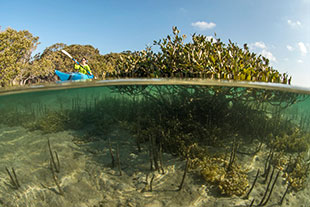
Seascapes
Estuaries, creeks and rivers

The park's 24 large estuaries cover approximately 920 hectares. They include
- The Clyde River – the only tide-dominated drowned river valley in the Batemans Shelf Bioregion
- An ocean embayment
- Sixteen intermittent estuaries (variations in salinity depending on freshwater input) – Coila and Durras lakes represent some of the bioregion's largest
- Six wave-dominated estuaries
Many of the estuaries are pristine – in particular the Clyde River and Lake Tarouga – largely because most of their catchment is incorporated within state forests or national parks.
Get up close and take a walk along the Cullendulla mangrove and estuary boardwalk.
Seagrass and mangroves
The park's coastline is dotted with estuaries, smaller coastal lakes and lagoons with abundant healthy seagrass and mangrove habitats.
- Seagrasses are important juvenile fish habitats.
- Mangroves support many interesting mud and sand dwelling critters such as marine snails (gastropods), oysters and microscopic crusteaceans.
- These vegetated habitats also help prevent erosion.
- Seagrass habitats (mostly Zostera capricorni and Posidonia australis) are well represented.
- Wagonga Inlet's clear blue waters are caused by the white sands found throughout its entrance and its deep, permanent ocean opening. The inlet is unique for having one of the state's healthiest seagrass Posidonia australis populations - an important juvenile fish and invertebrate habitat.
- Coastal lakes and lagoons - including Durras, Brunderee, Tarourga and Brou Lake - are highly significant intermittent estuaries.
- Durras Lake's extensive seagrass beds are important fish nurseries.
- The lake is habitat for several threatened seabird and migratory seabird species.
Rocky shores
This park is unique in NSW because it has a large proportion of rocky shores, both adjacent to the mainland and surrounding the islands.
- The rocky reefs are home to a diverse array of fish, with recent scientific shallow reef surveys finding more than 109 species.
- Schooling fish such as onespot puller (Chromis hypsilepis), mado (Atypichthys strigatus) and eastern hulafish (Trachinops taeniatus) are typically most abundant.
- The most abundant resident reef fish include white-ear (Parma microlepis), rock cale (Aplodactylus lophodon) and crimsonband wrasse (Notolabrus gymnogenis).
Reefs
Rocky reefs are one of the park's most common habitats.
- Lush forests of kelps and other large, brown seaweeds that often cover the shallower rocky reefs are a source of food and shelter to a myriad of marine animals, including commercially and recreationally important species such as abalone and lobster.

